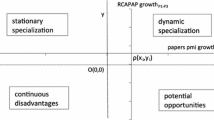Abstract
The article attempts to assess the results of the independent development of the CIS countries in the field of science over the period 1990–2009. The analysis of the numerous scientometric indicators reveals the decrease of the number of expert researchers and the significant decrease in the scientific and technical output. The article also provides the information about the dynamics of a set of indicators which allows to draw conclusions about the effectiveness of the research activity in the CIS countries.




Similar content being viewed by others
Notes
Regardless of the fact that Georgia has finished the process of the withdrawal from the CIS, considering its geographical location, historical and cultural connections with the CIS countries and the fact that it used to be an actual member of the CIS over the period 1993–2008, it seems appropriate to study the dynamics of Georgian science. However, as in the case of Turkmenistan and Uzbekistan, the analysis is complicated due to the lack of necessary data for this period.
See, for example, "Commonwealth of independent states in 2009".
See “Frascati manual”, pp. 30–34.
"Commonwealth of independent states in 2009", CD-ROM.
UNESCO Institute for statistics official internet site, “Predefined tables”, Table 25, http://stats.uis.unesco.org/unesco/TableViewer/tableView.aspx?ReportId=2655.
Researchers, as defined by “Frascati manual” are “professionals engaged in the conception or creation of new knowledge, products, processes, methods and systems and also in the management of the projects concerned”, Frascati manual, p. 93.
More ways to address the scientific staff, see «Frascati manual 2002», pp. 98–100 and «Canberra Manual», pp. 38–39.
Science and Engineering Indicators 2010, chapter 5, p. 30.
OECD Patent Statistics Manual (2009), pp. 86–87.
Ibidem, p. 60.
Strictly speaking, at our disposal there was data on the value of GDP and R&D works performed for 2009. However, since in 2009 the value of both these indicators were significantly influenced by late-2000s financial crisis (which appeared in CIS countries in full in 2009), it seems more appropriate (for demonstration of transitional crisis consequences) provide data for 2008.
Calculated on the basis of the World Bank database «WDI-online» (http://publications.worldbank.org/WDI) on the value of GDP at constant prices (national currency units).
Calculated on the basis of the «Official Statistics of the Countries of the Commonwealth of Independent States, 2008–13» CD-ROM, and the World Bank database «WDI-online» (http://publications.worldbank.org/WDI).
Calculated on the basis of «Official Statistics of the Countries of the Commonwealth of Independent States, 2008–13» CD-ROM.
Calculated on the basis of «Official Statistics of the Countries of the Commonwealth of Independent States, 2009–14» CD-ROM.
See: UNESCO Institute for statistics official internet site, “Predefined tables”, Table 4, http://stats.uis.unesco.org/unesco/TableViewer/tableView.aspx?ReportId=2660.
Calculated according to the official website of the World Intellectual Property Organization www.wipo.org, «Official Statistics of the Countries of the Commonwealth of Independent States, 2009–14» CD-ROM (for nine CIS countries) and UNESCO Institute for statistics official internet site, “Predefined tables”, Table 4 (for Belgium, Ireland, Spain), http://stats.uis.unesco.org/unesco/TableViewer/tableView.aspx?ReportId=2660.
Higher Attestation Commission (VAK) of Russia−the central state authority that oversees the awarding of advanced academic degrees and academic ranks. One of its functions in particular is to provide a unified policy in this field.* Ministry of Education and Science of the Russian Federation.
For example, the official website of Education and Science Control Committee of Kazakhstan recommends “the major scientific journals and publications of the Russian Federation” in the List of issues for publication of the main scientific results of dissertations. Source: http://www.educontrol.kz/ru/oficialnye_dokumenty/perechen_nauchnykh_izdanii/ .
JCR provides separate data for England, Scotland, Wales and Northern Ireland.
Calculated on the basis of “Journal citation reports” of Thomson Reuters’ “ISI Web of Knowledge” (www.isiknowledge.com).
Ibid.
Data cover ten-year (plus six month) period, from January 1, 2001 to June 30, 2011.
Reference
Commonwealth of Independent States in 2009. Statistical yearbook/Interstate Statistical Committee of the Commonwealth of Independent States−M., 2010 (CD-ROM).
Frascati Manual (2002). Proposed standard practice for surveys on research and experimental development, Paris.
ISI Web of Knowledge data base. www.isiknowledge.com.
Manual on the measurement of human resources devoted to S&T–canberra manual (OECD/Eurostat), Paris, 1995.
Official Statistics of the Countries of Commonwealth of Independent States, 2008-13, CD-ROM.
Official Statistics of the Countries of Commonwealth of Independent States, 2009-14, CD-ROM.
Pfetsch, F. R. (1990). The measurement of a country’s science and technological potential. Scientometrics, 19(5–6), 495–504.
Science and engineering indicators (2010). Arlington, VA: National Science Foundation (NSB 10-01).
WDI-online, World Bank’s data base, http://publications.worldbank.org/WDI.
World intellectual property organization’s official internet site, www.wipo.org.
Author information
Authors and Affiliations
Corresponding author
Rights and permissions
About this article
Cite this article
Karamourzov, R. The development trends of science in the CIS countries on the basis of some scientometric indicators. Scientometrics 91, 1–14 (2012). https://doi.org/10.1007/s11192-011-0592-6
Received:
Published:
Issue Date:
DOI: https://doi.org/10.1007/s11192-011-0592-6




